SOLON Publications
Members of the SOLON network have written monographs, edited volumes and contributed chapters to a number of texts
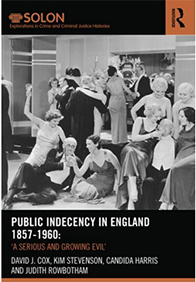 Public Indecency in England 1857-1960
'A Serious and Growing Evil’
Public Indecency in England 1857-1960
'A Serious and Growing Evil’
By David J Cox, Kim Stevenson, Candida Harris, Judith Rowbotham
(Routledge – 2015 – 198 pages)
Series: Routledge SOLON Explorations in Crime and Criminal Justice Histories
Throughout the nineteenth century and twentieth century, various attempts were made to define and control problematic behaviour in public by legal and legislative means through the use of a somewhat nebulous concept of ‘indecency’. Remarkably however, public indecency remains a much under-researched aspect of English legal, social and criminal justice history. Covering a period of just over a century, from 1857 (the date of the passing of the first Obscene Publications Act) to 1960 (the date of the famous trial of Penguin Books over their publication of Lady Chatterley’s Lover following the introduction of a new Obscene Publications Act in the previous year), Public Indecency in England investigates the social and cultural obsession with various forms of indecency and how public perceptions of different types of indecent behaviour led to legal definitions of such behaviour in both common law and statute. This truly interdisciplinary book utilises socio-legal, historical and criminological research to discuss the practical response of both the police and the judiciary to those caught engaging in public indecency, as well as to highlight the increasing problems faced by moralists during a period of unprecedented technological developments in the fields of visual and aural mass entertainment. It is written in a lively and approachable style and, as such, is of interest to academics and students engaged in the study of deviance, law, criminology, sociology, criminal justice, socio-legal studies, and history. It will also be of interest to the general reader.
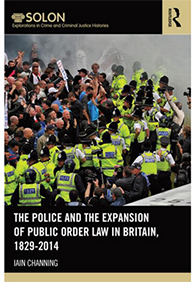 The Police and the Expansion of Public Order Law in Britain, 1829-2014
The Police and the Expansion of Public Order Law in Britain, 1829-2014
By Iain Channing
(Routledge – 2015 – 252 pages)
Series: Routledge SOLON Explorations in Crime and Criminal Justice Histories
Incidences of public disorder, and the manner in which they have been suppressed, have repeatedly ignited debate on the role of policing, the effectiveness of current legislation and the implications for human rights and civil liberties. These same issues have reverberated throughout British history, and have frequently resulted in the enactment of new legislation that reactively aimed to counter the specific concern of that era. This book offers a detailed analysis of the expansion of public order law in the context of the historical and political developments in British society. The correlation of key historical events and the enactment of consequent legislation is a key theme that resonates throughout the book, and demonstrates the expanding influence of the law on public assemblies and protest, which has continued to criminalise and prohibit certain social behaviours. Crucial movements in Britain’s social and political history who have all engaged in, or have provoked public disorder, are examined in the book. Other incidents of riot and disorder, such as the Featherstone Riot (1893), the Battle of Cable Street (1936), the Inner City Riots (1980s) and the UK riots (2011) are also covered. By positioning legal developments within their historical context, the book demonstrates the ebb and flow between the prominence of the competing demands of the liberties of free expression and assembly on the one hand and the protection of the general public and property on the other. This book is essential reading for academics and students in the fields of criminology, history and law.
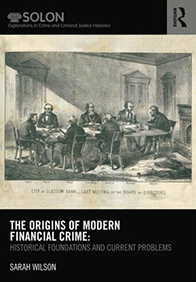 The Origins of Modern Financial Crime: Historical foundations and current problems in Britain
The Origins of Modern Financial Crime: Historical foundations and current problems in Britain
By Sarah Wilson
(Routledge – 2013 – 260 pages)
Series: Routledge SOLON Explorations in Crime and Criminal Justice Histories
The recent global financial crisis has been characterised as a turning point in the way we respond to financial crime. Focusing on this change and ‘crime in the commercial sphere’, this text considers the legal and economic dimensions of financial crime and its significance in societal consciousness in twenty-first century Britain. Considering how strongly criminal enforcement specifically features in identifying the post-crisis years as a ‘turning point’, it argues that nineteenth-century encounters with financial crime were transformative for contemporary British societal perceptions of ‘crime’ and its perpetrators, and have lasting resonance for legal responses and societal reactions today. The analysis in this text focuses primarily on how Victorian society perceived and responded to crime and its perpetrators, with its reactions to financial crime specifically couched within this. It is proposed that examining how financial misconduct became recognised as crime during Victorian times makes this an important contribution to nineteenth-century history. Beyond this, the analysis underlines that a historical perspective is essential for comprehending current issues raised by the ‘fight’ against financial crime, represented and analysed in law and criminology as matters of enormous intellectual and practical significance, even helping to illuminate the benefits and potential pitfalls which can be encountered in current moves for extending the reach of criminal liability for financial misconduct. Sarah Wilson’s text on this highly topical issue will be essential reading for criminologists, legal scholars and historians alike. It will also be of great interest to the general reader.
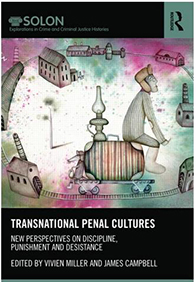 Transnational Penal Cultures: New Perspectives on Discipline, Punishment and Desistance
Transnational Penal Cultures: New Perspectives on Discipline, Punishment and Desistance
Edited by Vivien Miller and James Campbell
(Routledge SOLON: Explorations in Crime and Criminal Justice Series, 2014.)
Focusing on three key stages of the criminal justice process, discipline, punishment and desistance, and incorporating case studies from Asia, the Americas, Europe, Africa and Australia, the 13 chapters in this collection are based on exciting new research that explores the evolution and adaptation of criminal justice and penal systems, largely from the early nineteenth century to the present. They range across the disciplinary boundaries of History, Criminology, Law and Penology.
Journeying into and unlocking different national and international penal archives, and drawing on diverse analytical approaches, the chapters forge new connections between historical and contemporary issues in crime, prisons, policing and penal cultures, and challenge traditional Western democratic historiographies of crime and punishment and categorisations of offenders, police and ex-offenders.The individual chapters provide new perspectives on race, gender, class, urban space, surveillance, policing, prisonisation and defiance, and will be essential reading for academics and students engaged in the study of criminal justice, law, police, transportation, slavery, offenders and desistance from crime.
 Alcohol and Moral Regulation: Public Attitudes, Spirited Measures and Victorian Hangovers
Alcohol and Moral Regulation: Public Attitudes, Spirited Measures and Victorian Hangovers
Henry Yeomans
(Polity Press 2014 pp.)
Alcohol consumption is increasingly described as a contemporary, worsening and peculiarly British social problem that requires radical remedial regulation. Informed by historical research and sociological analysis, this book takes an innovative and refreshing look at how public attitudes and the regulation of alcohol have developed through time. It argues that, rather than a response to trends in consumption or harm, ongoing anxieties about alcohol are best understood as ‘hangovers’ derived in particular, from the Victorian period. The product of several years of research, this book aims to help readers re-evaluate their understanding of drinking. As such, it is essential reading for students, academics and anyone with a serious interest in Britain’s ‘drink problem.’
Contents: Introduction .1 Thinking about drinking 2. Temperance and teetotalism 3. Balancing act or spirited measure 4. The apogee of the temperance movement 5. An age of permissiveness 6. Alcohol, crime and disorder 7. Health, harm and risk 8. Conclusion.
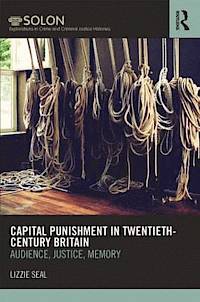 Capital Punishment in Twentieth-Century Britain
Audience, Justice, Memory
Capital Punishment in Twentieth-Century Britain
Audience, Justice, Memory
Lizzie Seal
(Routledge SOLON: Explorations in Crime and Criminal Justice Series, 2014 200pp.)
Capital Punishment for murder was abolished in 1965. At this time, the way people perceived and understood the death penalty had changed – it was an issue that had become increasingly controversial, high profile and fraught with emotion. In order to understand why this was, it is necessary to examine how ordinary people learned about and experienced capital punishment. Drawing on primary research, Capital Punishment in Twentieth-Century Britain explores the cultural life of the death penalty in Britain in the twentieth century. Groundbreaking in its attention to the death penalty and the effect it had on everyday life, this is the only text on this era to place public and popular discourses about, and reactions to, capital punishment at the centre of the analysis.
Contents: Introduction 1. Capital punishment since 1868 2. Audience, publicity and emotion 3. Trial and execution as entertainment 4. Popular protest against execution 5. Public responses to capital punishment 6. Haunted by the ghosts: Edith Thompson and Timothy Evans 7. Penal currents in the post abolition era 8. Negotiating memories of capital punishment.
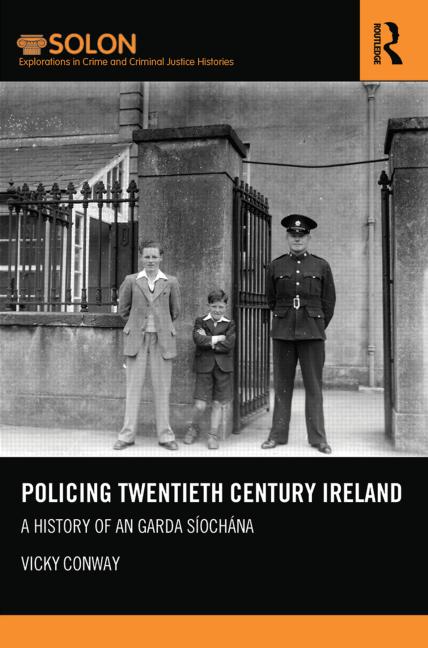 Policing Twentieth Century Ireland
A History of An Garda Síochána
Policing Twentieth Century Ireland
A History of An Garda Síochána
Vicky Conway
(Routledge SOLON: Explorations in Crime and Criminal Justice Series, 2013 264pp.)
This book critically evaluates the creation of the new police force an Garda Síochána, in the 1920s and analyses how this institution was influenced by and responded to substantial changes in Ireland. Beginning with an overview of policing in pre-independence Ireland, this book chronologically charts the history of policing in Ireland. It presents data from oral history interviews with retired Gardaí who served between the 1950s and 1990s giving unique insight into the experience of policing. Particular attention is paid to the difficulties of transition, the early encounters with the IRA, the policing of the Blueshirts, the world wars, gangs in Dublin, and the growth of drugs and crime.
Contents: Colonialism and politicised policing 1. An Garda Síochána: an ill-conceived birth 2. The 1930s and 40s: transition and political policing 3. The 1950s and 60s: a policeman’s paradise? 4. The Troubles and policing Ireland 5. The special branch and the Troubles 6. The end of the century: policing change 7. The twenty-first century: scandal, austerity reform and managerialism 8.
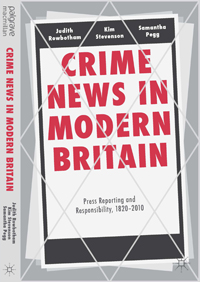 Press Freedom and Responsibility – Regulation and the Royal Charter
Press Freedom and Responsibility – Regulation and the Royal Charter
Judith Rowbotham, Kim Stevenson and Samantha Pegg, Crime News in Modern Britain. Press Reporting and Responsibility 1820-2010, with a Preface by Joshua Rozenberg (Palgrave Macmillan, published 16 October 2013). .
When it comes to newspaper reporting, exactly what constitutes the public interest? How justified is it, in the public interest, that ultimately, press freedom be managed (as all three political parties have recently agreed) by politicians? Equally, what do we mean by freedom of the press and to what extent can, and should, such press freedom be validated by the public interest? How can we reconcile the desire to inform, sometimes at all costs, with genuine public responsibility? On the one hand, many of us have felt increasingly outraged by press intrusions into the privacy not of celebrities (there is a long tradition of feeling that being ‘celebrated’ means giving up privacy to a considerable extent because we are ‘interested’ in such figures) but of private individuals whose media importance relates to some other story – usually linked in some way to a ‘crime’ story. On the other, there is a very long tradition of believing that (as The Times put it), one of the most important roles of a free press relies on its having the capacity to hold the political system as well as individual politicians to account. How can the press do this if that political system has the power to censor the press and control what it publishes?
Sensationalist newspaper coverage of crime has been a matter of keen public interest. But what role has sensationalist reporting played in creating public understanding of the criminal justice system in England and Wales? This book provides an answer, presenting an engaging account of crime reportage from the late eighteenth century to the present day; from the era of specialist reporters to the days of modern investigative journalism. Written in a lively and accessible style and locating familiar crime stories from Constance Kent to Sarah Payne in their contemporary presentations to newspaper readers, the chapters explore crime news in broadsheet, quality and tabloid publications and explain its importance to how the criminal justice system has been understood.
Contents: Introduction: A History of Crime News, 1.The Beginnings of Crime Intelligence 1800-1860 2. A ‘Golden Era’? 1860-1885 3. Challenging the Golden Goose? 1885-1900 4. New Journalism Triumphant: 1900-1914 5. New Perspectives and New Informants: 1914 to 1939 6. Enhancing Sensationalism: 1939-1960 7. Positively Criminal? Press, Police and Politicians: 1960s-2010 8. Online and Offline: Post Script 2011-
 Inter-war Penal Policy and crime in England: the Dartmoor Convict Prison Riot, 1932
Inter-war Penal Policy and crime in England: the Dartmoor Convict Prison Riot, 1932
Alyson Brown
(Palgrave Macmillan 2013, 208pp.)
.
One of the largest and most destructive riots in British history occurred in Dartmoor Convict Prison in 1932. Between 1932 and into the 1960s the Dartmoor ‘mutiny’ was the most widely known prison outbreak in British prison history. It was impossible for the prison authorities to deny the seriousness of the outbreak when smoke and flames could be seen for miles around billowing from buildings set alight by prison convicts. Press reports besieged Princetown, the village next to the prison, and a Daily Mirror airplane took dramatic photographs that helped to make this riot a national media event and one of the most dramatic stories of the 1930s.
Contents
Introduction 1. The Dartmoor Convict Prison Riot 1932- ‘wild happenings on the moor 2. A man seeking closure, Alexander Paterson, du Parcq and inter-war penal policy 3. Dartmoor gaol battle, The Dartmoor riot as a national media event 4. The Elephant and Castle gang and criminal careers of Dartmoor prison inmates 5. Microhistory and the modern prison 6. Conclusion 7.
 Shame, Blame, and Culpability - Crime and Violence in the Modern State
Shame, Blame, and Culpability - Crime and Violence in the Modern State
Judith Rowbotham, Marianna Muravyeva, David Nash.
Published 23rd July 2012 by Routledge This ground-breaking collection of research-based chapters addresses the themes of shame, blame and culpability in their historical perspective in the broad area of crime, violence and the modern state, drawing on less familiar territories such as Russia and Greece, not just on material from familiar locations in western Europe. Ranging from the early modern to the late twentieth century, the collection has implications for how we understand punishments imposed by states or the community today.
Contents
Foreword Xavier Rousseau Introduction Judith Rowbotham, Marianna Muravyeva and David Nash Part I: Theorizing Shame 1. 'Verguenza, Vergogne, Schande, Skam and Sram': Litigating for Shame and Dishonour in Early Modern Europe Marianna Muravyeva 2. ‘Fama,’ Shame Punishment, and History of Justice in the Sixteenth and Seventeenth Centuries Antonella Bettoni 3. Towards an Agenda for the Wider Study of Shame: Theorizing for Nineteenth Century British Evidence David Nash Part II: Rethinking Blame 4. The Shifting Nature of Blame: Revisiting Issues of Blame, Shame and Culpability in the English Criminal Justice System Judith Rowbotham 5. Guilty Before the Fact? The Deviant Body and the Chimera of ‘Precrime,’ 1877-1939 Neil Davie 6. The ‘Convict Stain’: Desistence in the Penal Colony Barry Godfrey Part III: Issues of Authority: Culpability and the Civilizing Imperative 7. Penance, Compensation, Terror: The Theory and Practice of Captial Punishment in Early Modern France, Paul Friedland 8. Hurt, Harm and Humiliation: Community Responses to Deviant Behaviour in Early Modern Scotland, Anne-Marie Kilday 9. Violence against Honor: Shame and the Crime of Rape in the Age of the Greek Revolution, 1821-1828 Katerini Mousadakou 10. 'Treat them According to the European Tradition': The Discourse of Blaming the Poor, the Problem of Professional Beggars and Attitudes to Poverty in Modern Russia, Julia Barlova 11. Shaming Punishments of Women in Russia in the Nineteenth and Early Twentieth Centuries Natalia Pushkareva 12. Insulting the Russian Royal Family: Crime, Blame and its Sources Boris Kolonitskij 13. Crime and Culpability in the Community, the Newspapers and the Courts: The Case of the Feuding Society of Crete (Greece) Aris Tsantiropoulos General Bibliography
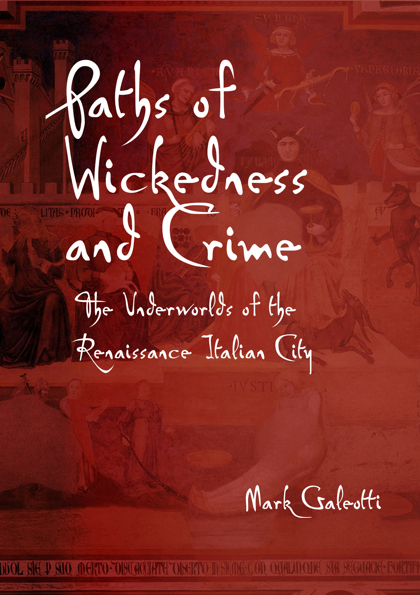 Paths of Wickedness and Crime: the Underworld of the Renaissance Italian City
Paths of Wickedness and Crime: the Underworld of the Renaissance Italian City
Mark Galeotti (Gonfalone, 2012 ISBN 9781300097440)
There were shadows to the Italian Renaissance. Just as art and philosophy were flourishing, so too were darker practices, from murder-for-hire to prostitution. However, despite popular parallels between families such as the Borgia and the Medici and the Mafia, there has been little systematic examination of the presence of organised crime in the era. In this short and lively essay, Mark Galeotti rereads and occasionally reinterprets the rich secondary literature from the perspective of a scholar of the modern underworld, to introduce a cast of corrupt princes, bandit chieftains, professional assassins, human traffickers, thugs and conmen and suggest that there were signs of the early beginnings of organised criminality in the towns and cities of late medieval and Renaissance Italy. An historian and political scientist, Mark Galeotti is Professor of Global Affairs at New York University's Center for Global Affairs.
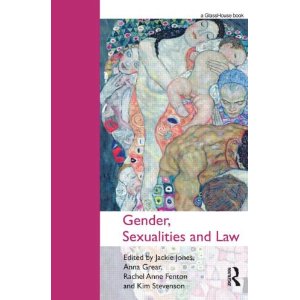 Gender, Sexualities and Law
Gender, Sexualities and Law
Jackie Jones, Anna Grear, Rachel Anne Fenton and Kim Stevenson, eds. 2011, Routledge.
Bringing together an international range of academics, Gender, Sexualities and Law provides a comprehensive interrogation of the range of issues – both topical and controversial – raised by the gendered character of law and legal discourse.
Contents
Part One: Theory, Law and Sex 1. Women and the Cast of Legal Persons, Ngaire Naffine 2. De/Sexing the Woman Lawyer, Rosemary Hunter 3. ‘Sexing the Matrix’: Embodiment, Disembodiment and the Law: Towards the Re-Gendering of Legal Personality?, Anna Grear 4. Vulnerability, Equality and the Human Condition, Martha A. Fineman Part Two: Representations, Law and Sex 5. The ‘Gendered Company’ Revisited, Alice Belcher 6. The Public Sex of the Judiciary: The Appearance of the Irrelevant and the Invisible, Leslie J. Moran 7. Sexuality, Gender and Social Cognition: Lesbian and Gay Identity in Judicial Decision-Making, Todd Brower 8. The Gendered Dock: Reflections on the Impact of Gender Stereotyping in the Criminal Justice System, Judith Rowbotham Part Three: Violence, Law and Sex 9. ‘She Never Screamed out and Complained’: Recognising Gender in Legal and Media Representations of Rape, Kim Stevenson 10. Gendering Rape: Social Attitudes towards Male and Female Rape, Phil N.S. Rumney and Natalia Hanley 11. When Hate is not Enough: Tackling Homophobic Violence, Iain McDonald 12. The Legal Construction of Domestic Violence: ‘Unmasking’ a Private Problem, Mandy Burton Part Four: International Violence, Law and Sex 13. Criminalization or Protection? Tensions in the Construction of Prevention Strategies concerning Trafficking for the Purposes of Sexual Exploitation, Anna Carline 14. A Woman’s Honour and a Nation’s Shame: ‘Honour Killings’ in Pakistan, Shilan Shah-Davis 15. Supranational Criminal Prosecution of Sexual Violence, Anne-Marie de Brouwer Part Five: Reproduction, Law and Sex 16. The Strange Case of the Invisible Woman in Abortion Law Reform, Kate Gleeson 17. Third-Wave Feminism, Motherhood and the Future of Feminist Legal Theory, Bridget J. Crawford 18. ‘Shall I be Mother?’ Reproductive Autonomy, Feminism and the Human Fertilisation and Embryology Act 2008, Rachel Anne Fenton, D. Jane V. Rees and Sue Heenan 19. Motherhood and Autonomy in a Shared Parenting Climate, Susan B. Boyd Part Six: Relationships, Law and Sex 20. A very British Compromise? Civil Partnerships, Liberalism by Stealth and the Fallacies of Neo-Liberalism, Jeffrey Weeks 21. Attitudes to Same-Sex Marriage in South African Muslim Communities: an Exploratory Study, Elsje Bonthuys and Natasha Erlank 22. Taking ‘Sex’ out of Marriage in the EU, Jackie Jones 23. From Russia (and Elsewhere) with Love: Mail Order Brides, Jennifer Marchbank
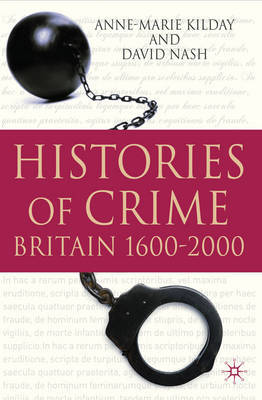 Histories of Crime Britain 1600-2000
Histories of Crime Britain 1600-2000
Anne-Marie Kilday and David Nash(PalgraveMacmillan 2010)
Summary
This book provides a rounded and coherent history of crime and the law spanning the past 400 years. It explores the evolution of attitudes towards crime and criminality over time. Through evocative case studies it highlights themes, current issues and key debates in the history of deviance and bad behaviour including marital cruelty and adultery, infanticide, murder, the underworld, blasphemy and moral crimes, fraud and white-collar crime, the death penalty and punishment.
Contents
Introduction Kilday and Nash
Moral Crimes and the Law in Britain since 1700 David Nash
Cruelty and Adultery: Offences against the Institution Joanne Bailey
Desperate Measures or Cruel Intentions? Infanticide in Britain since 1600 Anne-Marie Kilday
'Most Intimate Violations' Contextualising the Crime of Rape Kim Stevenson
Murder and Fatality: The Changing Face of Homicide Shani D'Cruze
Criminality, Deviance and the Underworld since 1700 Heather Shore
Fraud and White-collar Crime: 1850 to the present Sarah Wilson
Policing the Populace: The Road to Professionlaisation Chris Williams
Execution as Punishment in England 1750-2000 Judith Rowbotham
 Murder: Social and historical approaches to understanding murder and murderers
Murder: Social and historical approaches to understanding murder and murderers
Shani D’Cruze, Sandra Walklate, and Samantha PeggSummary
This book examines the issues associated with the crime of murder, drawing on detailed case studies as a way of exemplifying and exploring more general questions of socio-cultural responses to murder. It incorporates a historical perspective providing some fascinating examples from the past enabling readers to understand what has changed and what has remained the same within that socio-cultural framework. Recent high profiles cases including Hindley, Shipman, and Bulger are examined in this context.
Contents
Cataloguing murder
Devils and demons: the social construction
of murder and murderers
Murderous women
Murderous children
Murderous men: intimate and domestic killings
Murderous men: killing acquaintances and strangers
Conclusion: rendering them pathological
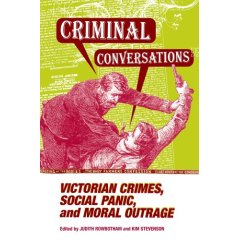 Criminal Conversations: Victorian Crimes, Social Panic, and Moral Outrage
Criminal Conversations: Victorian Crimes, Social Panic, and Moral Outrage
Judith Rowbotham and Kim Stevenson (Ohio State University Press 2005)
Summary
This second edited volume focuses on the ‘conversations’ that occurred primarily in the Victorian media around specific types of crime and bad behaviour and explains how the printed press presented and represented certain types of conduct and those responsible for such behaviour. Victorian newspapers offered a daily diet of cases from the summary courts educating the public about what was acceptable and unacceptable behaviour. Authors seek to set out such print conversations in their wider cultural context and in particular explore their relationships in the light of associated social and moral panics.
Contents
Introduction. Rowbotham and Stevenson
Beyond the bounds of respectable society : the "dangerous classes" in Victorian and Edwardian England. David Taylor
The press and the public visibility of nineteenth-century criminal children. Jane Abbott
Religion, rural society, and moral panic in mid-Victorian England. Gary Moses
A Victorian financial crisis: the scandalous implications of the case of Overend Gurney. Paul Barnes
Larceny : debating the "boundless region of dishonesty". Graham Ferris
Criminal savages? : or "civilizing" the legal process. Judith Rowbotham
Behaving badly? : Irish migrants and crime in the Victorian city. Roger Swift
Striking at Sodom and Gomorrah : the medicalization of male homosexuality and its relation to the law. Ivan Crozier
A mania for suspicion : poisoning, science, and the law. Tony Ward
A little of what you fancy does you ... harm!! (with apologies to Marie Lloyd). Sandra Morton
The eloquent corpse : gender, probity, and bodily integrity in Victorian domestic murder. Shani D’Cruze
She-butchers : baby-droppers, baby-sweaters, and baby-farmers. David Bentley
Sex, wives, and prostitutes : debating Clarence. Kate Gleeson
"Crimes of moral outrage" : Victorian encryptions of sexual violence. Kim Stevenson
"Kicked, beaten, jumped on until they are crushed," all under man's wing and protection : the Victorian dilemma with domestic violence. Susan Edwards
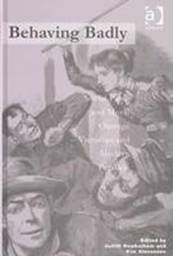 Behaving Badly: Visible Crime, Social Panics and Legal Responses - Victorian and Modern Parallels
Behaving Badly: Visible Crime, Social Panics and Legal Responses - Victorian and Modern Parallels
Judith Rowbotham and Kim Stevenson (Ashgate 2003)
Summary
This was the first publication arising from the SOLON research project based on utilising original newspaper material from the nineteenth century some of which is available on the SOLON database sourced and sponsored through an ESRC Small Grant Scheme Behaving Badly: Media Representations of ‘Crime’ and the Law – Victorian and Modern Parallels.
Both the Victorian age and the late twentieth century are often characterised by contemporaries as times of apparent economic affluence and stability. They are often depicted as periods that shared a conviction that the stability of society, including its affluence, was threatened by the activities of social deviants. These essays aim to examine crime of a socially visible nature, in the context of social panic and moral outrage in both the Victorian period and the late twentieth century. Through a series of interconnected case studies, exploring the social and legal responses to such offences and their public presentation through popular reporting and the court system, a series of apparent continuities as well as discontinuities are highlighted in the making of legislation.
Contents
Introduction: Behaving Badly. Rowbotham and Stevenson
Acquitting the innocent. Convicting the guilty. Delivering justice?, David Bentley
Causing a sensation: media and legal representations of bad behaviour, Rowbotham and Stevenson
Policing a myth, managing an illusion: Victorian and contemporary crime recording. Tom Williamson
Policing bad behaviour – interrogating the dilemmas. Roger Hopkins Burke
Law and disorder: Victorian restraint and modern panic. Kiron Reid
Moral cancers: fraud and respectable crime. Sarah Wilson
The blast of blasphemy. Government, law and culture confront a chill wind. David Nash
A dangerous obsession? Gambling and social stability. Mike Ahearne
Legislating morality: Victorian and modern legal responses to pornography. Tom Lewis
Penny dreadfuls and perverse domains: Victorian and modern moral panics. Gavin Sutter
Discourses of denial and moral panics: the pornographisation of the child in art, the written word, film and photograph. Susan Edwards
Why can't a woman be more like a man? Attitudes to husband-murder 1889–1989. Judith Knelman
Gendered assumptions – madness, pregnancy and childbirth. M.E. Rodgers
From unlawful assembly to aggravated trespass: the control of protest in the 1880s and 1990s. Richard Stone
Link to Review by Lesley Hall http://www.lesleyahall.net/behbadly.htm
